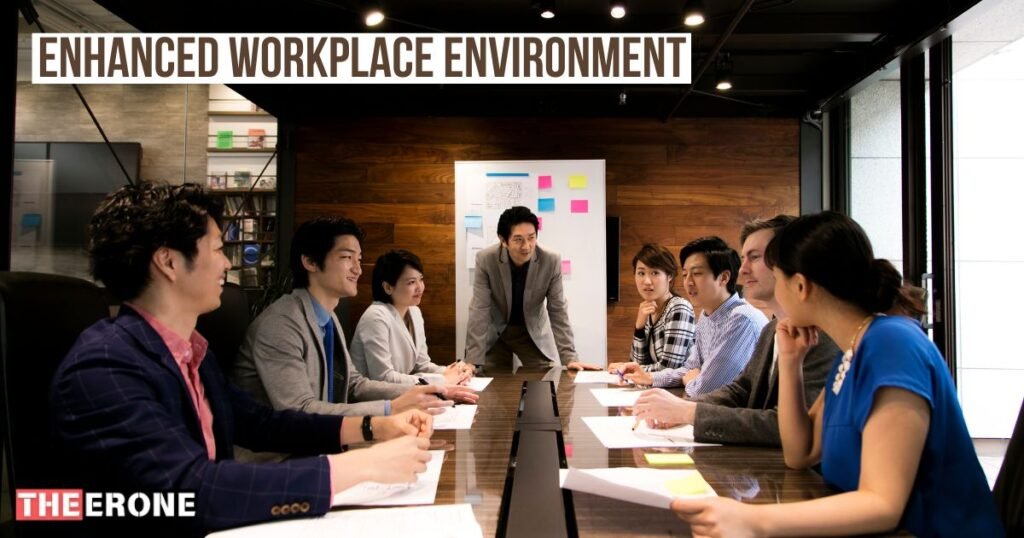Technology is primarily responsible for workplace changes. Tools like artificial intelligence, cloud computing, and smart devices have changed how we work, communicate, and handle chores. Business leaders, HR managers, and IT specialists must understand these developments to boost productivity while preserving competitiveness.
This blog will examine how modern technology has changed the workplace. We will explore the opportunities and challenges it has brought about, from boosting efficiency to changing communication, enabling distant work, and even posing new problems.
How Has New Technology Affected the Modern Workplace?
What kind of workforce will exist in the future? Technological advances will completely change where and how people work.
Improved Productivity and Efficiency
Automation of Repetitive Tasks
Technology has simplified workflows by automating repetitive operations that once required hours of manual labor. AI and machine learning-powered tools quickly and precisely comprehend complex data. Businesses use automation to reduce human error, save time, and free up workers for more vital work.
For instance, payroll management programs like Gusto and QuickBooks automate time tracking and tax filing. Similarly, AI-driven chatbots for customer service handle routine questions, allowing human agents to zero in on more complex problems.
Also Read: Role of Technology Modernization in Digital Transformation
Advanced Project Management Tools
Modern project management platforms like Asana, Trello, and Slack help teams work together quickly. Features such as task assignment, progress tracking, and real-time communication simplify workflows. To ensure projects are finished on time, teams can, for example, set up dashboards to track deadlines.
These tools promote cooperation even between departments by crossing the divide between divided teams. This degree of framework and transparency is essential to productivity in fast-paced settings.
Real-Time Data and Analytics
The availability of real-time data has changed how businesses make choices. Companies may make decisions based on facts rather than intuition using actionable insights from Tableau and Google Analytics. Companies are more adept at spotting patterns, adjusting their plans, and predicting outcomes.
For example, retail companies analyze customer behavior to refine marketing strategies. Meanwhile, Supply chain managers use predictive analytics to prepare for changes in demand. With its ability to provide fast, data-driven insights, technology has become an essential tool for success.
Also read: What is the Difference Between Public and Private Blockchain Networks?
Revolutionized Communication
Instant Messaging and Video Conferencing Tools
Thanks to technology, many personal interactions are no longer needed. Instant messaging apps like Slack and Microsoft Teams enable real-time communication, and platforms like Zoom and Google Meet facilitate virtual meetings.
For instance, teams working remotely can now effortlessly interact in the same city or on the opposite side of the world. These approaches have substantially reduced the need for costly and time-consuming business travel while maintaining connectivity.
Global Connectivity
Technology has broken down geographical barriers, creating a connected global workforce. Businesses can engage with clients and team members from anywhere, strengthening collaborations. Thanks to tools like Teams and collaborative platforms like Figma, a designer in New York can brainstorm with a client in Tokyo in real time.
However, global connectivity isn’t without challenges. Time zone differences and the prevalence of constant notifications can overwhelm employees. Tools like email scheduling and status visibility help manage communication expectations.
Challenges of Overcommunication
While communication tools boost collaboration, they can also lead to overcommunication. Constant notifications and the expectation to reply immediately may lead to burnout. Striking a balance is vital—encourage employees to set boundaries and schedule focused distraction-free work hours.
Managers must also adopt tools that organize communications efficiently, prioritizing critical updates to reduce overwhelm.
Remote Work and Flexibility

Rise of Remote Work
Technology has been pivotal in enabling remote work. Tools like VPNs, cloud computing, and virtual desktops allow employees to perform tasks from anywhere. Popular tools like Zoom, Slack, and Google Drive have become essentials for businesses adopting remote models.
The flexibility remote work provides has boosted job satisfaction and enabled companies to tap into global talent pools. For example, a developer in Croatia can seamlessly collaborate with a marketing team in the United States.
Hybrid Work Models
Hybrid work models, which blend in-office and remote work, are becoming the norm. Technology supports this flexibility through tools that keep employees connected regardless of location. Features like shared drives and virtual brainstorming sessions ensure productivity isn’t compromised.
Businesses exploring hybrid setups must focus on cohesive experiences for both in-office and remote employees. Equally accessible tools and inclusive virtual meetings foster team unity.
Challenges of Remote Work
Remote work also has challenges. Time zone differences can create delays, while virtual teams may struggle with cohesion. Building trust and engagement in remote settings requires innovative approaches, like virtual team-building exercises.
Cybersecurity is another concern, as remote setups rely on cloud-based tools. To mitigate risks, enterprises must invest in robust cybersecurity measures like encryption and VPNs.
Reshaped Job Roles and Skills
Emergence of New Job Roles
The advent of technology has created roles that didn’t exist a decade ago—AI specialists, data analysts, and cybersecurity experts are just a few examples. Businesses now rely on tech-savvy leaders to drive change and innovation.
At the same time, traditional roles are evolving. For example, accountants increasingly use cloud-based software, while teachers adopt e-learning platforms to enhance education delivery.
Need for Upskilling and Reskilling
Professionals must adapt to thrive in this evolving workplace. Lifelong learning is essential as technology continually changes business landscapes. Online platforms like Coursera, Udemy, and LinkedIn Learning offer accessible courses for developing in-demand skills.
Employers also foster skill development. Offering training programs ensures employees stay relevant, driving business success.
Impact on Job Market Dynamics
While highly beneficial, automation does raise concerns about job displacement. However, it also creates roles requiring human creativity and emotional intelligence. Striking a balance between job automation and new opportunities is vital for a stable workforce.
Enhanced Workplace Environment

Smart Office Technology
Innovative office solutions powered by the Internet of Things (IoT) enhance workplace environments. Automated climate control, lighting systems, and space management tools create more efficient, comfortable workplace spaces.
Companies investing in innovative tech also see reduced energy consumption and improved sustainability.
Wellness and Health Monitoring
Technology is also advancing employee wellness. Fitbit and Garmin are examples of smartwatches that motivate employees to prioritize physical activity and track health parameters. Apps for mental health offer tools for coping with stress or anxiety, demonstrating how companies are putting a premium on overall well-being.
Ethical and Security Challenges
Cybersecurity Concerns
As businesses use more technology, they need to protect their systems more. They are more vulnerable to threats like data leaks and cyberattacks. Advanced solutions like multi-factor authentication and encryption ensure secure operations.
Privacy Issues
Monitoring tools can violate employee privacy even when they increase effectiveness. It’s crucial to find a balance between tracking outcomes and respecting boundaries.
Ethical Implications of AI
AI raises ethical dilemmas—from biases in decision-making to job displacement. Transparent algorithms and inclusive training datasets minimize unfairness, ensuring ethical adoption.
Balancing Technology’s Potential with Responsibility
The influence of technology in the workplace is undeniable. It has enhanced productivity, fostered communication, and redefined business possibilities. Yet, its challenges—cybersecurity risks, privacy concerns, and job displacement—demand careful attention.
For businesses to benefit fully, they need to balance optimization with responsibility. By leveraging technology wisely and ethically, companies can create workplaces prioritizing efficiency and employee well-being.
Conclusion
New technology has altered workplaces, increasing flexibility, productivity, and communication. Businesses now use digital solutions for smooth team and location collaboration. Automation may reduce routine operations, save money, and save time.
Employees enjoy remote work options, which create better work-life balance and increased satisfaction. However, challenges like cybersecurity risks and data privacy need constant attention. When technology is used responsibly, workplaces remain inclusive, equitable, and productive. Businesses may prosper and build a better future for everyone by making sensible adjustments.
FAQs
How has technology affected the modern business world?
Technology has increased efficiency and connectivity in the business world. Digital tools simplify communication and collaboration. Automation reduces repetitive tasks for better productivity. Technology also supports remote work, improving flexibility and work-life balance. Businesses must address data security challenges responsibly.
What are the 5 ways technology is changing the way we work?
Technology enables remote work, promotes automation, and boosts productivity with innovative tools. It enhances global collaboration by connecting teams instantly. Cloud storage keeps data organized and accessible. These innovations create flexibility while improving efficiency in every aspect of work.
How does technology affect the work we do?
Technology automates repetitive tasks, saving time for creative and strategic work. It simplifies communication and manages data faster. Employees use tools for better collaboration and problem-solving. By adapting to technology, businesses achieve goals and deliver better results.
How has the modern industry changed the workplace?
Modern industry embraces advanced technology for more innovative ways of working. Workplaces are now more flexible and connected. Digital tools improve efficiency and reduce errors. Automation reshapes traditional roles while enabling innovation. Businesses create competitive value with technology-driven practices.












